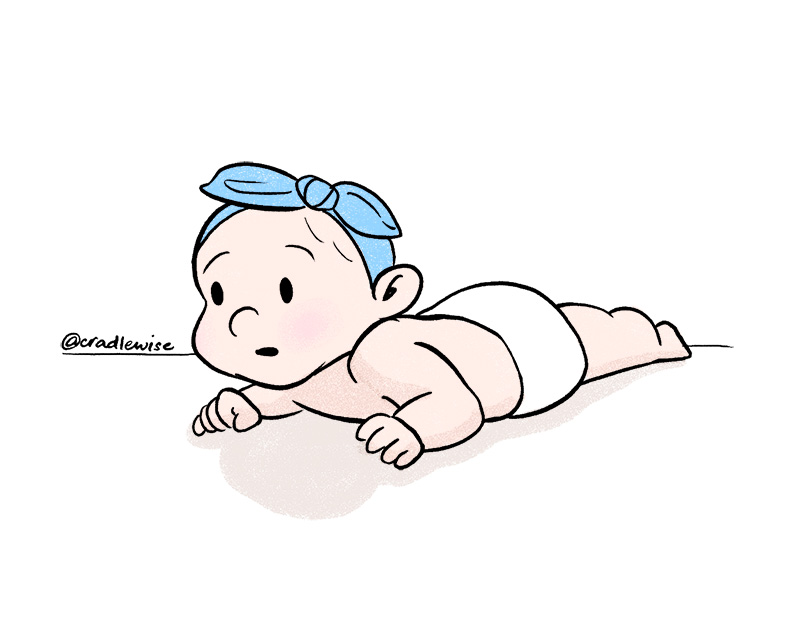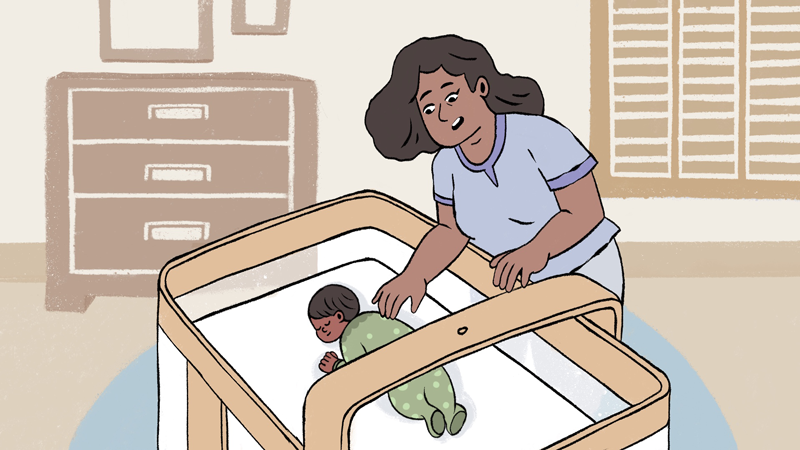Science of baby sleep
0 min read
When do babies start to roll over on their own?

Cradlewise Staff
Every little milestone your baby reaches feels like a major triumph. One exciting milestone is when your baby starts to roll over independently. It’s an incredible moment that marks their growing independence and physical development.
It’s also one of the first big milestones in your baby’s journey of growing up. Being able to roll over on their own is the first step before they soon learn to sit on their own, then crawl, and eventually take their first steps. And it all starts with them learning how to roll over on their own.
Here’s everything you need to know about this milestone and how you can help your baby achieve it.
When do babies roll over?
While there is no exact timeframe, most babies typically start rolling over around the age of four to six months.
“ By 6 months, most babies can roll from front to back. Around -3-4 months, they may be able to roll to the side.
— Dr. Kimberly Langdon, an MD with 19 years of clinical experience as an obstetrician and gynecologist at Medzino.
Rolling over is an exciting developmental milestone for babies as they gain more control over their bodies. Rolling over usually begins with babies mastering the ability to roll from their stomachs onto their backs. As they continue to strengthen their neck and back muscles and improve their coordination, they progress to rolling from their backs onto their stomachs.
However, it’s important to remember that every baby develops at their own pace, so some may start rolling over earlier or later than this general timeframe.
For some babies, this milestone may come as early as four months, while for others it might take a bit longer. So, don’t fret if your little one hasn’t rolled over yet. Remember, every baby has their own timeline!
When do babies roll over from tummy to back?
The first type of rolling over your baby will likely accomplish is from tummy to back.
Many babies start rolling from tummy to back as early as four months. So, keep an eye out for those adorable belly-to-back flips!
This milestone usually occurs once they have gained enough strength in their neck and upper body muscles. As they develop better control and coordination, they can push up on their arms and lift their head, enabling them to shift their weight and roll over onto their back.
These might look like they’re trying to do a little push-up.
When do babies roll over from back to belly?
On the other hand, rolling over from back to tummy usually happens a bit later, around five to seven months of age.
This skill requires further development of their core muscles and improved motor skills. Babies will begin by rolling onto their side and gradually progress to a full roll from their back onto their tummy.
It’s essential to create a safe environment during this stage to prevent accidental falls or injuries as they explore and practice their newfound ability to roll over.
Why do babies roll over?

According to Dr. Nilong Vyas (MD, Pediatrician), founder of Sleepless at NOLA, rolling is the first major motor developmental milestone that builds muscle strength to ultimately progress to walking. Babies are usually interested in a toy or object that encourages them to roll from one side to another.
Babies roll over as a natural developmental milestone that emerges due to various reflexes.
One of these reflexes is the asymmetric tonic neck reflex, commonly known as the fencing reflex, which causes a baby to turn their head to one side while extending the arm and leg on the same side.
This reflex encourages them to lift their head and initiate the rolling motion when lying on their back. As babies gain strength in their neck and core muscles and improved coordination, the fencing reflex gradually fades, giving way to purposeful movements and greater independence in their motor skills.
According to Dr. Kimberly Langdon “Babies want to move as soon as they are born, but it takes time for muscles and nerves to coordinate and for the baby to get stronger.”
What if my baby rolls over while sleeping?

It’s an exciting time when your little champion develops the ability to roll over.
On the one hand, it’s a significant milestone you can’t help but encourage; on the other, it also means keeping an extra eye on their safety.
When your baby starts to roll on their own, it’s a good time to go over your childproofing list again, and ensure that their floor play area has no choking hazards lying around, like tiny toys or small objects.
Dr. Vyas says, “Babies can sleep on their stomachs safely once they get there independently, which can be as early as 4 months of age. Babies should not be placed on their stomachs to sleep; however, they can stay there once they roll to their stomachs independently.”
While you can supervise them when you’re awake, parents often worry about what to do if your baby rolls over while sleeping.
While this is considered a normal milestone in their development, you’ll want to ensure that their sleeping environment is safe to minimize potential risks.
- Continue placing your baby on their back to sleep.
- Remove any loose bedding or soft objects from the crib or sleeping space. This reduces the risk of suffocation and ensures proper airflow.
- Stop swaddling. Once your baby can roll over, swaddling restricts their movements when they’re asleep, which is a potential suffocation hazard.
According to Dr. Vyas, arms-out sleep sacks are still okay to use, as babies may need the use of their arms/hands to help themselves roll back. - Avoid placing the baby to sleep on surfaces where they can easily roll off, such as sofas or adult beds.
“For SIDS prevention, it is ideal for the baby to sleep on its back, not the side, chest, or stomach,” says Dr. Vyas, “However, if the baby transitions herself there independently, it is okay to leave her there unless there is distress.”
How to help a baby roll over
You can assist your baby in getting to this milestone. Here are some tips that might help:
- Encouraging tummy time: Place your baby on their tummy for short periods throughout the day, gradually increasing the duration. This helps strengthen their neck, shoulders, and core muscles for rolling over.
- Engaging playtime: Use toys or objects that capture your baby’s attention on one side to encourage them to reach and grab. This can motivate them to attempt rolling over as they try to reach for the object.
- Gentle assistance: While your baby is lying on their back, you can gently guide their legs toward one side to initiate the rolling motion. Be careful not to force or rush this process, as babies develop at their own pace.
- Supporting side-lying: During playtime or diaper changes, prop your baby on their side using a rolled-up towel or a nursing pillow. This can help them get used to the feeling of being on their side and build the strength necessary for rolling over.
- Providing floor space: Create a safe and spacious area on the floor for your baby to explore and move around. Remove any hazards and place soft cushions or blankets around to cushion potential falls.
- Celebrating milestones: Offer lots of praise and encouragement when your baby achieves small milestones, such as pushing up on their arms or attempting to roll over.
Positive reinforcement can motivate them to continue their efforts and build their confidence in rolling over independently. Remember that every baby develops at their own pace, so be patient and supportive throughout the process.
Remember, creating a safe and supportive environment before doing all these activities is important.
What to do if a baby shows no signs of rolling over
“Some babies are slower to roll, which may be a concern to bring up to the pediatrician if no signs of rolling at all in either direction occur by six months,” says Dr. Vyas.
So if a baby is not showing signs of rolling over by around six to seven months, it’s a good idea to consult their pediatrician for a developmental assessment to ensure everything is progressing normally. They can assess your baby’s development and provide guidance.
More about baby milestones
- When do babies sit up?
Babies generally begin sitting up with support around four to six months; by six to eight months, they can often sit unsupported.
- When can babies hold their heads up?
Babies can typically hold their heads up steadily and without support by around three to four months of age.
- When do babies start crawling?
Babies typically start crawling between 6 to 10 months of age.
- When do babies start walking?
Babies generally start walking between 9 to 15 months of age.
FAQs
Q: What is the earliest a baby will roll over?
A: Babies typically start rolling over from their back to their tummy at around four to six months, but some may do it as early as three months.
Q: When do babies start grabbing things?
A: Babies start to develop the ability to grasp objects between three and six months, but they may only have a precise grip around six to nine months.
Q: Can a baby roll over at two months?
A: Some babies can roll over at two months, but it’s uncommon. Most babies start rolling over between three to six months.
Q: When do babies roll over from tummy to back?
A: Babies usually start rolling over from their tummy to their back between four and seven months of age.
You may also like



